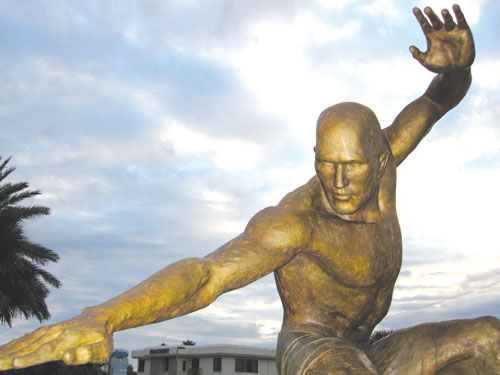![]()
HOME------FICTION------NON-FICTION------LOCALS------ABOUT![]()
Slater, in Bronze
Originally published in The Beachside Resident

The drive through Cocoa Beach has changed forever. The moment they pulled the tarp from the Kelly Slater statue on A1A, our kitschy little stretch of asphalt swelled up and tilted ever-so-slightly seaward. City engineers working traffic for the ceremony confirmed the half-inch inclination of the road, but could not explain why or how it happened. They could only speculate… Kelly Slater, after all, has transformed things far greater than roads.
Slater, the man who revolutionized a millenia-old sport, attended the unveiling at Triangle Park on November 17. The park (a small, pedestrian-inaccessible cleft of landscaping where the road splits in two) was packed with adoring fans who stood behind hedges or up on ladders, eager to snap photographs of the living legend. Chairs were spread out on the grass for Kelly’s family, his boyhood surfing crew, the Mayor, Tony Sasso, surfing icons like Matt Kechele and Dick Catri. The customary speeches were made. The Governor himself provided a handwritten statement. When the strings were finally pulled for the great reveal, the congregation drew in a collective breath. Kelly walked a full circle around the sculpture, eyes glowing. The equilibrium of the barrier island teetered.
The crowd lingered late, each fan waiting their turn with the man, chattering excitedly, posing for pictures. By evening, they disbanded. The statue remained. It’s what statues do best. They’re persistent. They remain, long after those who raised them are boxed away.
If you drive down A1A from the north, the sculpture will catch you by surprise. Here it is –– behind three tall flagpoles, hidden among power lines, cabbage palms, shopfronts, backgrounded by a waterfall –– a masterfully constructed bronze sculpture. The fact that you are passing it at 44 miles per hour adds to the effect — a golden surfer, appearing from nowhere, tail-slides across your line of sight.
The figure doesn’t scream for your attention. He doesn’t raise his sword to the heavens. He's not standing tall or audacious, or even looking at you. But he pulls you in somehow, draws your attention for a moment from the degraded behemoth of the Glass Bank across the street.
Then he is behind you. But the elegant gesture has been imprinted on your mind.
The Slater statue's placement is symbolic. Once you have driven past it, you are officially in "The Streets" of Slater's fabled childhood.
Approach the Kelly Slater statue by foot (the most accessible parking spots are at the gas station immediately south of the triangle), and the first thing you will notice is the graceful handling of the upper hand. There, in the detail of Slater’s fingers is the hyper-realism of Greek sculpture, bent ahead of the face, supple, fluid of wrist, a magician’s hand, beckoning the ocean and simultaneously withdrawing from it.
The sculptor, Tasha Drazich, modeled the pose from a 1998 photo taken at Sebastian Inlet, in which Slater is executing a high cutback and throwing off a massive fan of spray. The challenge of capturing such a maneuver in bronze was solved by the inventive use of a live model suspended on ropes. The leaning aspect of the piece calls to mind another famous sculpture — Frederic Remington’s 1857 “Mountain Man” — in which a bronze horse and rider are caught in the act of descending a precipitous slope. Like Remington’s horse, the bronze Slater’s ankles are fixed, his weight shifted to the back. And yet Slater is more controlled than the Mountain Man, his motion down the line more decisive.
If you stand at the base of the statue, you will notice the giant toes, bearish, overlarge. Also, the element of Rodin in the pressed flesh. Peer closer and observe another curiosity: every inch of Slater’s skin is striated with tiny lines, as if the bronze has been run over with a surfer’s wax comb.
Now, an upward glance at face. You are struck with the feeling that this is not quite Kelly’s face… Something is off. Is it the nose? The eyes? The irisless orbs emit a sort of transcendent distance. It is hard to say. The original photograph depicted a younger Kelly, head full of hair, cheeks puffed out, neck taut with exertion. Here we have the iconic shaved head, and this strange, serene face, monk-like in its calmness.
The surfboard––shaped by Kechele––was perhaps the most difficult element of the statue to reproduce in the bronze forge. Its surface is smooth as a bell, the rails full and rounded. It has no fin, perhaps so that the untrained eye might not think Slater is surfing backwards. The surfboard is mounted on a domed base, where nine of Slater’s eleven world titles are engraved on the bronze — 2010 and 2011 have yet to be added.
Walking, like Kelly, full circle around the statue, you can appreciate the cut of the shoulders, the muscles of the calves, the shape of the jaw-line. Here, you come to understand how the physical gifts of the gymnast can be coupled with the creative inspiration of the artist. The aura is undeniable… this could be no one else but Kelly Slater — here, in the extra layer of air beneath the board; in the perfect balance; in the steady and unflinching suggestion that through thought alone we guide ourselves through time and space.
We erect statues to honor immortals. When the immortal dies, the statue remains. Perhaps it is there to teach us something. Or to remind us to be better.
That the greatest surfer of all time first dipped his board into these very waters, these mushy waves of Cocoa Beach, teaches us something. It is the same thing the Kelly Slater statue shows us every time we drive past: the most beautiful gestures can be found in the most unexpected pockets.
Welcome back to the Streets, Kelly.
![]()
